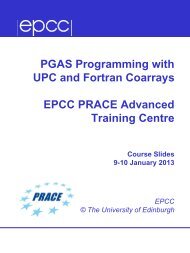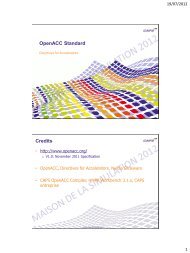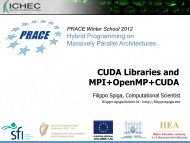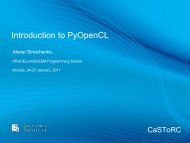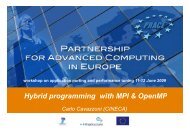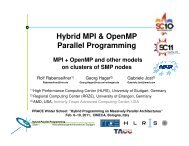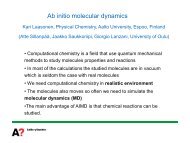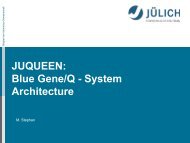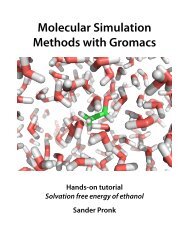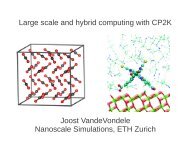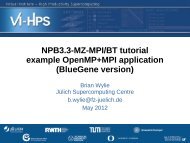Hybrid MPI and OpenMP programming tutorial - Prace Training Portal
Hybrid MPI and OpenMP programming tutorial - Prace Training Portal
Hybrid MPI and OpenMP programming tutorial - Prace Training Portal
You also want an ePaper? Increase the reach of your titles
YUMPU automatically turns print PDFs into web optimized ePapers that Google loves.
Summary• This <strong>tutorial</strong> tried to– help to negotiate obstacles with hybrid parallelization,– give hints for the design of a hybrid parallelization,– <strong>and</strong> technical hints for the implementation “How To”,– show tools if the application does not work as designed.• This <strong>tutorial</strong> was not an introduction into other parallelization models:– Partitioned Global Address Space (PGAS) languages(Unified Parallel C (UPC), Co-array Fortran (CAF), Chapel, Fortress, Titanium,<strong>and</strong> X10).– High Performance Fortran (HPF) Many rocks in the cluster-of-SMP-sea do not vanishinto thin air by using new parallelization models Area of interesting research in next yearsConclusions• Future hardware will be more complicated– Heterogeneous GPU, FPGA, …– ccNUMA quality may be lost on cluster nodes– ….• High-end <strong>programming</strong> more complex• Medium number of cores more simple(if #cores / SMP-node will not shrink)• <strong>MPI</strong>+<strong>OpenMP</strong> work horse on large systems• Pure <strong>MPI</strong> still on smaller cluster• <strong>OpenMP</strong> on large ccNUMA nodes(not Cluster<strong>OpenMP</strong>)Thank you for your interestQ&APlease fill in the feedback sheet – Thank you<strong>Hybrid</strong> Parallel ProgrammingSlide 153 / 154Rabenseifner, Hager, Jost<strong>Hybrid</strong> Parallel ProgrammingSlide 154 / 154Rabenseifner, Hager, JostBOOKAbstractAppendix• Abstract• Authors• References (with direct relation to the content of this <strong>tutorial</strong>)• Further referencesHalf-Day Tutorial (Level: 20% Introductory, 50% Intermediate, 30% Advanced)Authors. Rolf Rabenseifner, HLRS, University of Stuttgart, GermanyGeorg Hager, University of Erlangen-Nuremberg, GermanyGabriele Jost, Texas Advanced Computing Center, The University of Texas at Austin, USAAbstract. Most HPC systems are clusters of shared memory nodes. Such systems can be PCclusters with single/multi-socket <strong>and</strong> multi-core SMP nodes, but also "constellation" type systems withlarge SMP nodes. Parallel <strong>programming</strong> may combine the distributed memory parallelization on thenode inter-connect with the shared memory parallelization inside of each node.This <strong>tutorial</strong> analyzes the strength <strong>and</strong> weakness of several parallel <strong>programming</strong> models on clustersof SMP nodes. Various hybrid <strong>MPI</strong>+<strong>OpenMP</strong> <strong>programming</strong> models are compared with pure <strong>MPI</strong>.Benchmark results of several platforms are presented. The thread-safety quality of several existing<strong>MPI</strong> libraries is also discussed. Case studies will be provided to demonstrate various aspects ofhybrid <strong>MPI</strong>/<strong>OpenMP</strong> <strong>programming</strong>. Another option is the use of distributed virtual shared-memorytechnologies. Application categories that can take advantage of hybrid <strong>programming</strong> are identified.Multi-socket-multi-core systems in highly parallel environments are given special consideration.Details. https://fs.hlrs.de/projects/rabenseifner/publ/SC2010-hybrid.html<strong>Hybrid</strong> Parallel ProgrammingSlide 155 / 154Rabenseifner, Hager, Jost<strong>Hybrid</strong> Parallel ProgrammingSlide 156 / 154Rabenseifner, Hager, Jost



